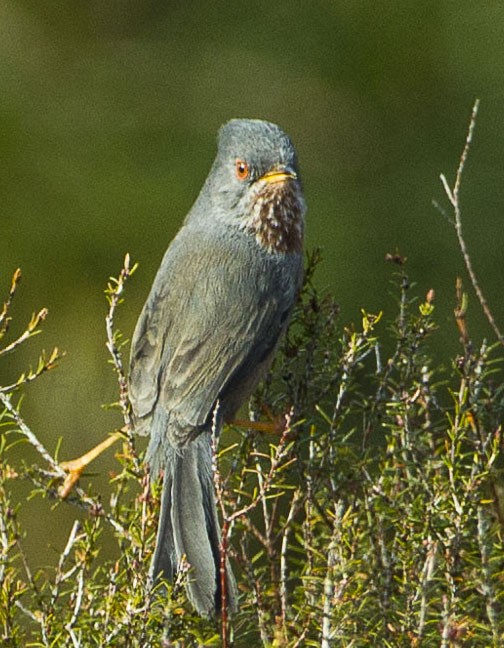Dartford Warbler
A species of Typical Old World Warblers Scientific name : Curruca undata Genus : Typical Old World Warblers
Dartford Warbler, A species of Typical Old World Warblers
Botanical name: Curruca undata
Genus: Typical Old World Warblers
Content
Description People often ask General Info
 Photo By Francesco Veronesi , used under CC-BY-SA-2.0 /Cropped and compressed from original
Photo By Francesco Veronesi , used under CC-BY-SA-2.0 /Cropped and compressed from original Description
The Dartford warbler is a small (13 cm (5.1 in)) passerine bird, distinguished by its long tail compared with that of other warblers. Its plumage comprises unobtrusive and muted tones, which blend in with the dry dead plants, old wood or sunny greyish wood found in its preferred habitats. Like many typical warblers, the Dartford warbler has distinct male and female plumages. The male has a grey back and head, reddish underparts, and a red eye. The reddish throat is spotted with white. The sides are a dull greyish tone, being more clear about the abdomen. In some populations males have bluish-grey or brownish-grey backs and heads. The female is paler below, especially on the throat, and a browner grey above. The female's throat also has white spots, although they are smaller and less marked than in the male. Juvenile birds are similar to females. 
Size
12 cm
Nest Placement
Shrub
Feeding Habits
Dartford Warbler predominantly consumes insects such as caterpillars, butterflies, beetles, and spiders. It forages in shrubs, displaying a preference for dense, thorny vegetation both for feeding and nesting.
Habitat
The species is naturally rare. The largest European populations of Sylvia undata are in the Iberian peninsula, others in much of France, in Italy and southern England and south Wales. In Africa it can be found only in small areas in the north, wintering in northern Morocco and northern Algeria. 
Dite type
Insectivorous
People often ask
General Info
Feeding Habits
Bird food type
Sounds
Call
Recording location: Portugal
Song
Recording location: Portugal
Song
Recording location: Portugal
Distribution Area
The species is naturally rare. The largest European populations of Curruca undata are in the Iberian peninsula, others in much of France, in Italy and southern England and south Wales. In Africa it can be found only in small areas in the north, wintering in northern Morocco and northern Algeria. 
Species Status
Dartford warblers almost died out in the United Kingdom in the severe winter of 1962/1963 when the national population dropped to just ten pairs. Sylvia undata is also sensitive to drought affecting breeding success or producing heath fires, as occurred during 1975 and 1976 in England when virtually all juveniles failed to survive their first year. However, this species can recover well in good quality habitat with favourable temperatures and rainfall, thanks to repeated nesting and a high survival rate for the young. Indeed, they recovered in some areas of the UK, but numbers are once again on the decline in other regions of their natural range. The range of the Dartford warbler is restricted to western and southern Europe. The total population in 2012 was estimated at 1.1–2.5 million breeding pairs. The largest numbers occur in Spain where there were believed to be 983,000–1,750,000 pairs. For reasons that probably include loss of suitable habitat, the Spanish population appears to be declining. The species is therefore classed by the International Union for Conservation of Nature as being Near threatened. A period of climatic warming since 1963 has seen the UK population increase to "more than 2,500 pairs in 2006 (Wotton et al. 2009). Expansion into patches of structurally suitable habitat (up to an altitude of 400m), more northerly areas and away from the core of the range, from Dorset and Hampshire to Derbyshire and Suffolk, is likely to have been facilitated by milder winter weather (Wotton et al. 2009, Bradbury et al. 2011)... The Dartford warbler population in the UK is expected to continue to increase. However, future climate-based projections for the European range indicate that by 2080, more than 60% of the current European range may no longer be suitable (Huntley et al 2007). There is evidence that this is happening already, with severe declines in Spain and France (Green 2017). For this reason, the species is classified as Near Threatened on the IUCN Global Red List. If the declines in southern Europe continue, the UK will become increasingly important for global conservation of this species". 